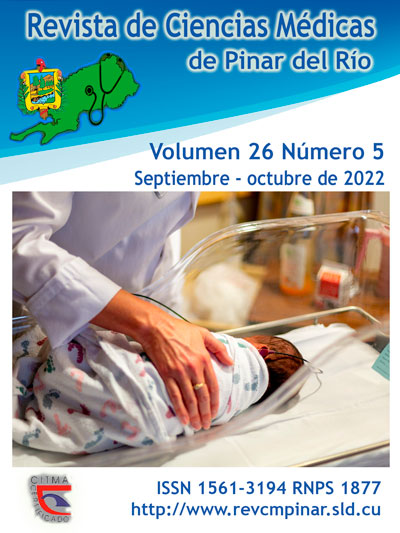Ethical considerations of the communicative process. Pediatric patient-physician relationship with hematological malignancies in primary care
Keywords:
ETHICS, MEDICAL, COMMUNICATION, PHYSICIAN-PATIENT RELATIONS.Abstract
Introduction: The physician-patient relationship requires an ethical approach that assumes its maximum expression in communication. This relationship becomes important and complex when it is established with pediatric patients with hematological malignancies and their families.
Objective: to characterize the contents of the ethical dimension of the communicative process in the pediatric patient-physician relationship with hematological malignancies in primary care.
Methods: a descriptive, non-experimental, cross-sectional study with a qualitative design was carried out. The phenomenological method and empirical level methods were used. The focal group was formed by 15 pediatricians of primary health care belonging to the "1ro de Enero" Polyclinic of the Consolación del Sur municipality. The research categories were the ethical dimension, the communicative process and the doctor-patient relationship. The results were processed establishing regularities and frequencies.
Results: there is a positive valuation of the pediatric doctor-patient relationship with malignant hemopathy. The criteria on the emotional handling of information and coherence in the forms of expression establish limitations to the communicative process, the overuse of technologies, waiting processes, low socio-cultural level of some families, as well as their dysfunctionality. Difficulties are reported for diagnosis due to limitations or delay in complementary processing, which generates anxiety in the family.
Conclusions: The ethical dimension of the communicative process in primary care is susceptible to be improved considering greater use of informed consent, involving the subject of care and considering the resources that support it.
Downloads
References
1. Pérez Cárdenas M. La ética en salud. evolución histórica y tendencias contemporáneas de desarrollo; 2003 pág. 2-8.
2. Lizaraso Caparó F, Benavides Zúñiga A. Ética Médica. Horiz. Med. [Internet]. 2018 Oct [citado 29/04/2020]; 18(4):4-8. Disponible en: http://www.scielo.org.pe/scielo.php?script=sci_arttext&pid=S1727-558X2018000400001
3. World Health Organization. Palliative care [Internet]. Consultado el 3 de julio de 2021. Disponible en: www.who.int/westernpacific/health-topics/palliative-care
4. Ortiz García M, Portuondo Alacán O, Ahuar López L, Rodríguez Rivalta I. La ética en la práctica pediátrica. Rev Cubana Pediatr . [Internet]. 2004 [citado 01/04/2020]; 76(3). Disponible en: http://scielo.sld.cu/scielo.php?script=sci_arttext&pid=S0034-75312004000300010
5. Weaver MS, Mooney-Doyle K, Kelly KP, Montgomery K, Newman AR, Fortney CA, et al. The benefits and burdens of pediatric palliative care and end-of-life research: A systema¬tic review. J Palliat Med[Internet]. 2019 [citado 01/04/2020]; 22(8):915-26. Disponible en: https://pubmed.ncbi.nlm.nih.gov/30835596/
6. Pérez Ulla LE, García Sánchez D, Rodríguez Jorge B, Ramos Cuellar L. Resiliencia en madres de pacientes pediátricos con enfermedades hematológicas. Acta méd centro [Internet]. 2019 [citado 01/04/2020]; 13(3). Disponible en: http://scielo.sld.cu/scielo.php?script=sci_arttext&pid=S2709-79272019000100378
7. Matos Águila D, Mercerón Figuerola Y. Potenciación de la capacidad de resiliencia en familiares de niños con cáncer mediante un programa de intervención psicosocial. MEDISAN [Internet]. 2017 [citado 10/03/2020];21(3):379. Disponible en: http://medisan.sld.cu/index.php/san/article/view/1195
8 Esquijarosa Roque B M, Guillén Cánovas A M, Álvarez Reinoso S, Bazabe Márquez M I, Hernández García J. Enfermedades hematológicas graves en la unidad de cuidados intensivos pediátricos pinareña. Rev. Ciencias Médicas [Internet]. 2017 ago. [citado 29/04/2020]; 21(4):48-55. Disponible en: http://scielo.sld.cu/scielo.php?script=sci_arttext&pid=S1561-31942017000400008&lng=es.
9. Martakis K, Brand H, Schröder-Bäck P. Desarrollo de la autonomía del niño en la atención pediátrica: hacia un modelo ético. Arch Argent Pediatr[Internet]. 2018 [citado 29/04/2020]; 116(3): e401-e408. Disponible en: http://www.scielo.org.ar/scielo.php?script=sci_abstract&pid=S0325-00752018000300016
10. Ruiz López J, Navarro-Zaragoza J, Carrillo Navarro P. Dilemas éticos en la práctica de la medicina infantil F12 Cuadernos de Bioética XXVIII 2017/1ª. 2017 [citado 01/04/2020]. Disponible en: http://aebioetica.org/revistas/2017/28/92/29.pdf
11. Tasso M. Perspectiva Bioética en Oncología Infantil Aplicación del método deliberativo para la resolución de conflictos éticos en oncología pediátrica. Pediatra. Servicio de Oncología Infantil EIDON[Internet]. 2013 [citado 01/04/2020]; 39: 49-60. Disponible en: https://revistaeidon.es/public/journals/pdfs/2013/39_junio.pdf
12. Spector-Bagdady K Retiinking te importance of te individual within a Community of Data. Hasting Center Report[Internet]. 2020 [citado 01/04/2020]; 2020; 50(4). Disponible en: https://doi.org/10.1002/hast.1112
13. Vargas E. La ética de la participación de niños en investigación clínica. Pediátr Panamá[Internet]. 2020 [citado 01/04/2020]; 49(3):96-7. https://pesquisa.bvsalud.org/portal/resource/pt/biblio-1177159
14. Ballesteros del Olmo JC. Aspectos éticos del acto médico. Rev Mex Pediatr[Internet]. 2018 [citado 01/04/2020]; 85(4):146-151. Disponible en: https://www.medigraphic.com/pdfs/pediat/sp-2018/sp184g.pdf
15. Arenas-Rivera J. Bioética y alimentación al final de la vidaen pediatría: dos perpectivas complementarias sobre un mismo tema. Rev. Nutr. Clin. Metab[Internet]. 2021 [citado 01/04/2020]; 4(Supl.1):99-105. Disponible en: https://revistanutricionclinicametabolismo.org/index.php/nutricionclinicametabolismo/article/download/324/497/3843
Downloads
Published
How to Cite
Issue
Section
License
Authors who have publications with this journal agree to the following terms: Authors will retain their copyrights and grant the journal the right of first publication of their work, which will be publication of their work, which will be simultaneously subject to the Creative Commons Attribution License (CC-BY-NC 4.0) that allows third parties to share the work as long as its author and first publication in this journal are indicated.
Authors may adopt other non-exclusive license agreements for distribution of the published version of the work (e.g.: deposit it in an institutional telematic archive or publish it in a volume). Likewise, and according to the recommendations of the Medical Sciences Editorial (ECIMED), authors must declare in each article their contribution according to the CRediT taxonomy (contributor roles). This taxonomy includes 14 roles, which can be used to represent the tasks typically performed by contributors in scientific academic production. It should be consulted in monograph) whenever initial publication in this journal is indicated. Authors are allowed and encouraged to disseminate their work through the Internet (e.g., in institutional telematic archives or on their web page) before and during the submission process, which may produce interesting exchanges and increase citations of the published work. (See The effect of open access). https://casrai.org/credit/



